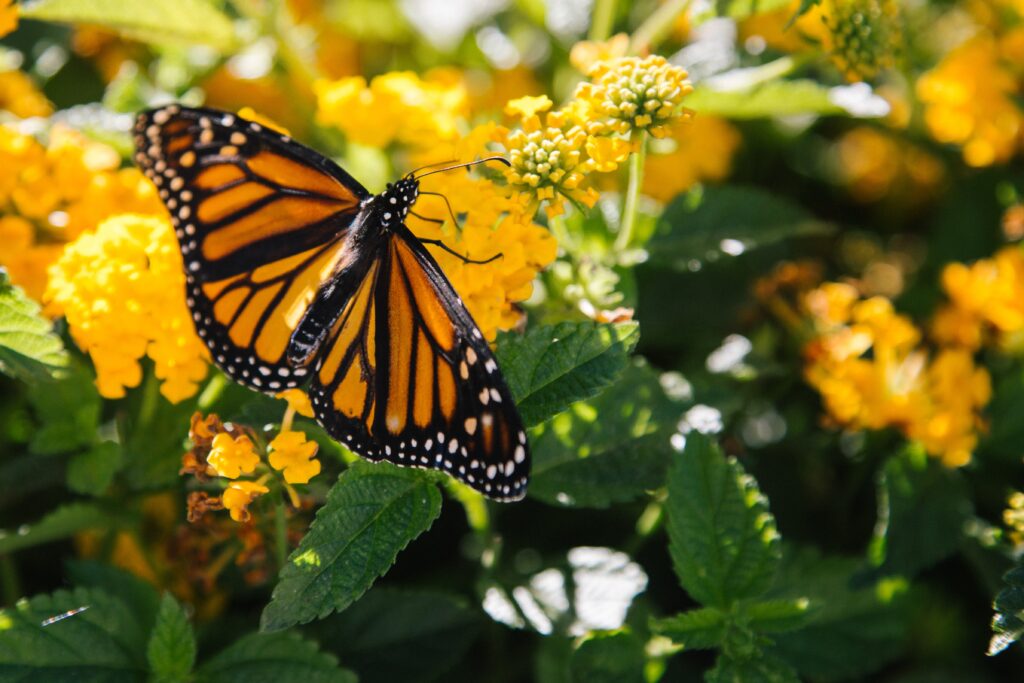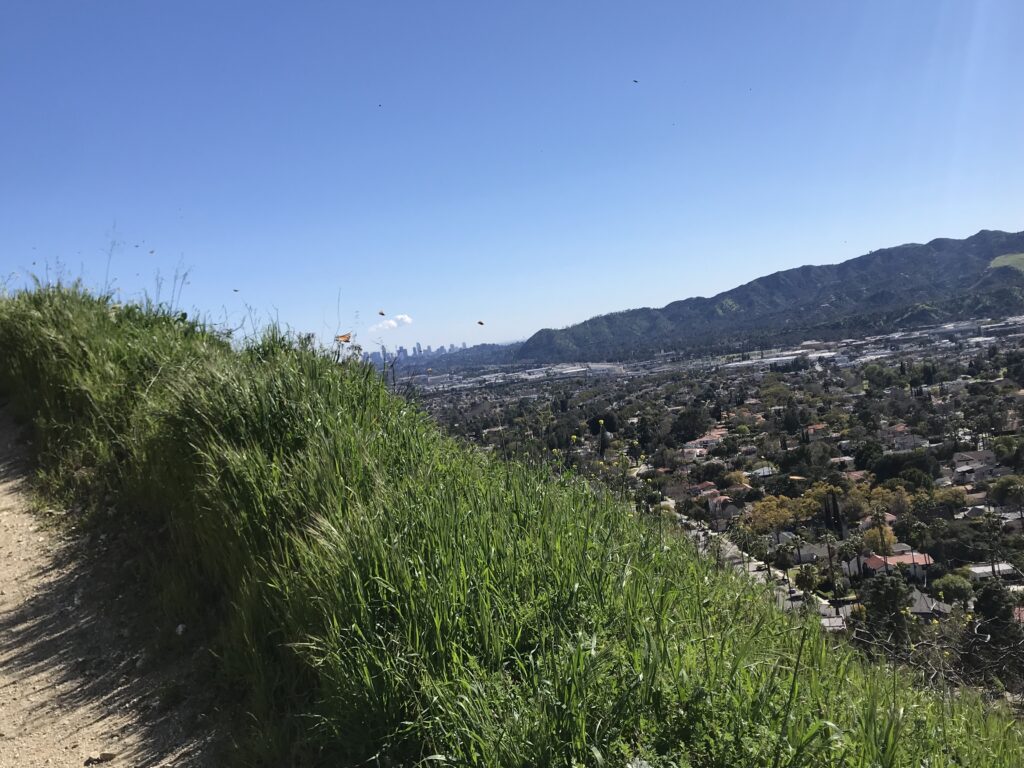Reconciliation Ecology: Protecting Monarch Butterflies in Southern California
Carolin Khanlari | April 19, 2022

Southern California has long been known as the center of center of film and television. An international destination of nearly 24 million people, that has attracted residents and visitors from all over the world for work, education, entertainment and opportunity. But for far longer, it has been an annual destination for Western Monarch Butterflies (Danaus plexippus), as they escape the harsher winters of the north. Yet, like many species, sprawling urbanization has destroyed and degraded much needed habitat for the Monarch, and brought inhospitable conditions due to the use of herbicides, insecticides, introduced predators and other human impacts. The situation has prompted many calls to action, including a 2021 Los Angeles Times article by Jeanette Marantos, where she decries “This is not a drill.” If we are to save the Western Monarch, the time is “Right now, folks, it’s up to us.”
The Migration
Monarch butterflies migrate yearly across North America in a visibly spectacular fashion. Eastern Monarchs travel up to 2,800 miles from the northeast United States, and southeast Canada to the mountain forests in central Mexico, where they find the right climate conditions to hibernate from the beginning during the winter. According to Monarch Milkweed Mapper, migrations of nearly 700 million Eastern Monarchs were documented in the 1990s. Less well known are the annual migrations of the Western Monarchs, originating in northern inland areas west of the Rocky Mountains, and migrating annually to the California coast as well as central Mexico. While the western migration is substantially smaller, these populations also exceed one million butterflies as recently as the 1990s.
In addition to allowing the species to survive the winter while being a spectacular photographic attraction, this long-distance migration has additional biological value. First, the caterpillars of monarchs are a crucial food source for the majority of songbirds, which heavily rely on insects as the source of food. Second, butterflies like bees, are valuable pollinators, assisting the plants to produce seeds which helps plants reproduce.
Neuroscientists have studied Monarchs in an effort to understand long-distance wildlife migration. It has been determined that the butterflies use the sun as a compass for both the migration south and the remigration north. In other words, the butterflies utilize a light-dependent, magnetic compass as an orientation system during migration.
According to the Monarch Milkweed Mapper, most overwintering sites in southern California are within two miles of the coast, as these sights offer protection from freezing temperatures and higher humidity. Tree species commonly used for roosting include native western sycamore (Platanus racemosa) and coast live oak (Quercus agrifolia), as well as nonnative species such as blue gum eucalyptus (Eucalyptus globulus) and red gum eucalyptus (Eucalyptus camadulensis). Winter flowering plants provide nourishment for the butterflies in the form of nectar.

The Decline
The decline in migration populations has been documented since 1997 by the annual Western Monarch Count, a community science program sponsored by the Xerces Society. In its initial year, the count documented 1.2 million butterflies over the Thanksgiving weekend, monitoring just over 100 sites. In 2021, the number was less than 250,000, with more than 250 sites monitored – a nearly 80% decrease in population over the 25 year period, spread over 2.5x the number of monitoring sites. This was despite a significant increase population from historically low numbers from the Thanksgiving count between 2018-2020.
A number of factors have been identified to explain this decline, but by far the most significant is habitat loss, both in terms of migratory sites in the south and summer sites in the north. In southern California, urban development associated with the expanding Los Angeles region has displaced overwintering habit for Monarchs as well as other native butterfly species. The main habitat of the El Segundo Blue Butterfly (Euphilotes battoides allyni) stretches along the coastal dunes of Los Angeles from Palos Verdes to Ocean Beach, and inland to the Los Angeles International Airport. Extensive development along the coastline led to the destruction of the El Segundo Blue’s habitat, the sea-cliff buckwheat (Eriogonum parvifolium). The El Segundo Blue needs this buckwheat to start life as an egg before it crawls like a caterpillar to the base of the plant. In addition to displacement from development, management practices, such as extensive pruning and the use of hazardous pesticides and herbicides degrade habitat conditions that remain.

Protection Strategies
Reconciliation ecology points to the establishment, and maintenance of new habitats to protect species diversity in human-inhabited places. Changes in historical disturbances and landscape practices require proactive flora and environment management in conserving and expanding butterfly populations.
The fragmentation and elimination of native habitats upon which butterflies are dependent pose a serious threat. Habitat restoration and management plans focused on selecting appropriate sites, appropriate plants, and supporting successive vegetation management activities can promote restoration efforts. Many cities have started campaigns to protect monarchs and other butterflies by establishing butterfly gardens in parks, home gardens, and other places. Saint Louis, Missouri, is one such city, described in a 2019 article by Bloomberg News. According to Catherine Werner, Saint Louis’s sustainability director quoted in the Bloomberg article, “there are more than 400 monarch gardens that have been registered on [our] site, and a quick look at the map shows that people all across the city have embraced this project.” The designing of urban green spaces such as pollinator gardens can play a significant role in conserving and restoring native biodiversity.
In southern California, a network of overwintering habitats should be created, maintained, and protected. There should be an array of monarch environments along the coastline that provides diverse vegetation, including desirable tree species for roosting, such as the Western Sycamore and Coast Live Oak, as well as plants that flower in winter and early spring to provide valuable nectar for nourishment. Milkweeds (Asclepias spp.) that are native to southern California should be prioritized. The Xerces Society recommends early emerging species such as woollypod (A. eriocarpa), California (A. californica), and heartleaf (A. cordifolia) milkweeds, and later-emerging species such as narrowleaf (A. fascicularis) and showy (A. speciosa) milkweeds. Jeanette Marantos describes the unintended dangers of using exotic milkweed.
There should also be a plan for long-term management that include preventing excessive pruning of roosting sites and eliminates the use of pesticides. Once a habitat is established, before any habitat modification, a qualified butterfly biologist should be involved before any decisions to alter the landscape are made. This is especially true for special sites such as Monarch’s overwintering sites, where tens of thousands of butterflies congregate on an annual basis. The rationale is that once a Monarch’s overwintering habitat has been damaged, the population is destabilized, and reestablishment is challenging. The Xerces Society publishes management guidelines for overwintering habitats.
Because butterflies are so beloved by people, designing restored habitats and urban gardens for monarchs and other butterflies can help improve survival of butterfly species and foster human engagement with nature.

Carolin Khanlari is a graduate student in the Master of Landscape Architecture program at California State Polytechnic University, Pomona. She holds a BFA in Interior Architecture from California State University Long Beach. Her passion for artistic, sustainable design and combining interior space with the exterior environment led her to extend her Interior education into Landscape Architecture. She believes by combining the two interior design and landscape architecture fields, she can create dynamic urban areas that have green structures with efficient and responsible water management, adequate biodiversity, good air quality, and excellent climate adaptation. She hopes to build her own firm where she can have a positive impact both in people’s living spaces and the outdoor environments for a sustainable and healthy balance.